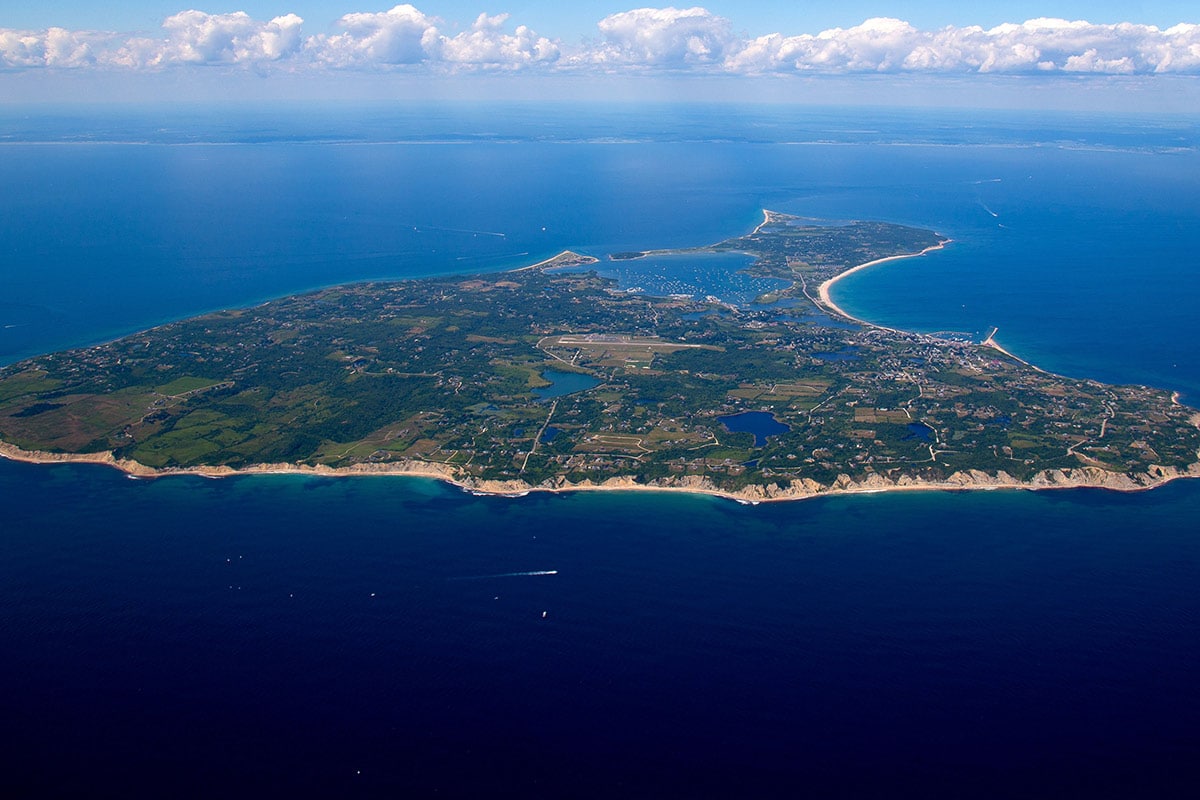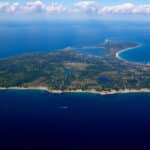Located about 10 miles south of Port Galilee, Block Island is considered part of Washington County. The year-round population of only 1,400 makes it the least-populous municipality in the Ocean State. However, with over hundreds of freshwater ponds, 17 miles of coastal beach, 30 miles of walking trails, with breathtaking ocean views, and 2 man-made harbors, the seasonal tourism business that the island attracts is its life blood. People come from all over to enjoy the quaint charm, sun-drenched beaches, and nightlife that Block Island offers. Although 3 miles wide and 7 miles long, the distinctive pork chop-shaped island has a long and interesting history.
Block Island was formed by the same receding glaciers that formed part of Cape Cod, the Hamptons, Martha’s Vineyard, and Nantucket, during the end of the last Ice Age. It was called “Manisses” (little island) by the Niantic people, who migrated from nearby coastal areas to inhabit the island, as long ago as 500 BC. Italian explorer, Giovanni da Verrazzano, was the first European to note the existence of Block Island in 1524, calling it “Claudia,” in honor of the Queen of France who died that year. However, some maps at the time referred to Rhode Island’s little island as “Luisa,” after the Queen Mother of France, the mother of King Francis I. It was nearly a century later, in 1614, that Dutch explorer, Adriaen Block, “re-discovered” the island and named it after himself.
Block Island would play a seminal role in the brutal Pequot War (1636-37), a struggle fought between the dominant Pequot people, who subjugated dozens of other tribes throughout the area, during this time, and English settlers in the region, together with their Native American allies, including the Narragansett and Mohegan tribes. It was the first sustained conflict between Native Americans and Europeans in northeastern North America. In July 1636, trader and noted rabble rouser, John Oldham, was found murdered on a ship off of Block Island, which brought a swift military response by the English of Massachusetts Bay. Ninety soldiers, under the command of John Endecott, were sent to Block Island, as well as to other territories in Connecticut, initiating the Pequot War.
Massachusetts Bay Colony claimed the island by conquest, and in 1658, the colony sold the island to a group of men, headed up by Endecott. English colonists from Massachusetts began settling on the island, and in 1664, it became part of the English colony of Rhode Island. Block Island was incorporated by the Rhode Island general assembly in 1672, and the island government adopted the name, “New Shoreham, after Shoreham Kent of England.
From 1690 to 1704, the town was invaded by privateers, 4 times while England was at war with France, and in 1699, vicious pirate, Captain William Kidd, paid a visit to the island, shortly before his capture in Boston. During the American Revolution, between 1775 and 1783, the New Shoreham remained neutral, trading freely with both sides.
Because the island is surrounded by dangerous shoals and ledges, dozens of vessels went down in its waters before two lighthouses were built and rebuilt over the years. With no natural harbors, breakwaters were constructed in 1870, forming Old Harbor on the east side. New Harbor was created in 1895, when a channel was dug to connect the Great Salt Pond to the ocean through the northwestern side of the island.
During the War of 1812, the island was briefly occupied by the British Navy, under the command of Sir Thomas Hardy. British vessels including HMS Terror, the same warship that would infamously become bound in ice, while seeking to complete a crossing of the Northwest Passage. Hardy took the fleet to Block Island in search of food and to establish a strategic position at the mouth of Long Island Sound. The British were enraged to discover that nearly all Block Island livestock and food stores had been transferred to Stonington, Connecticut, in advance of their arrival. In August 1814, Hardy and his fleet departed Block Island for Stonington Harbor, in part to lay claim to the Block Island food stores and livestock. Hardy’s pre-dawn raid the following day, became known as the Battle of Stonington.
By the middle of the 19th century, steamships provided outsiders easy access to the island, changing it forever and establishing a thriving and lasting tourism industry. Sprawling hotels and fine dining restaurants were to accommodate the influx of travelers, who had plenty of nearby destination options where they could spend their summer hours and travel dollars.
During World War II, several artillery spotters were located on the island to direct fire from the heavy gun batteries at Fort Greene in Point Judith, which protected the entrance to Narragansett Bay. Lookout positions for the spotters were built to look like houses. The U.S. government offered to evacuate the island, as it could not be effectively defended from enemy invasion, but the islanders chose to stay. Days before the war ended against Germany, the Battle of Point Judith took place seven miles to the northeast of the island.
The Block Island Conservancy was founded in 1972, and since then, approximately 1/3 of the island has been protected from development. The Town, working in collaboration with community organizations, has been very successful in conserving open space and preserving the community’s natural and cultural heritage.
The world is constantly changing, sometimes too fast, but on Block Island, the pace is always a little slower, and before the summer of 2023 is history, New Shoreham is a perfect destination that is just a brief and relaxing ferry ride away.










